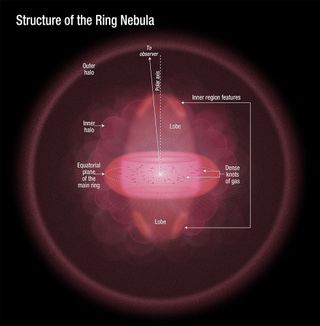Hubble Telescope Reveals True 3D Shape of Ring Nebula (Photos)

The iconic Ring Nebula may seem like just a stunning circle of wispy interstellar gas, but new images from the Hubble Space Telescope reveal it to be more like a deep-space jelly doughnut, scientists say.
The new Hubble telescope images have allowed astronomers to take their most detailed look at the Ring Nebula than ever before, revealing an unprecedented view of the nebula's three-dimensional structure.
"The nebula is not like a bagel, but rather, it's like a jelly doughnut, because it's filled with material in the middle," study leader C. Robert O'Dell, an astronomer with Vanderbilt University in Nashville, Tenn., said in a statement today (May 23).

In addition to seeing the new images, astronomers were able to create a video of the Ring Nebula's structure with the Hubble telescope data.
The Ring Nebula is just over 2,000 light-years from Earth in the Lyra constellation and is 1 light-year (about 6 trillion miles, or 10 trillion kilometers) wide. The nebula formed 4,000 years ago when a dying star several times the mass of our sun ran out of its nuclear fuel.
The star then swelled in size to become an immense red giant, and then began shedding its outer layers of gas as it collapsed in on itself to become a white dwarf. Intense ultraviolet light from the star heats up the surrounding gas to make it glow, Hubble researchers explained.
Today, the Ring Nebula is a popular stargazing target for amateur astronomers, because its ring-like shape is face-on to Earth, making it an easily identifiable object when viewed through telescopes. But the new Hubble Space Telescope observations show that the Ring Nebula is not a perfect ring at all.
Get the Space.com Newsletter
Breaking space news, the latest updates on rocket launches, skywatching events and more!

Hubble's powerful Wide Field Camera 3 revealed a complicated 3D structure that permeates, and at times extends out from, the primary nebula mass. Scientists combined the images with ground-based observations and found the prominent ring-like structure of the nebula appears to wrap around a blue-hued feature shaped like a football, with the ends of the "football" jutting out from the ring's border.
O'Dell's team was surprised to find irregular knots of dark, dense gas along the inner ring of the nebula like spokes in a wheel, NASA officials said.
"These gaseous tentacles formed when expanding hot gas pushed into cool gas ejected previously by the doomed star," Hubble officials explained in an image description. "The knots are more resistant to erosion by the wave of ultraviolet light unleashed by the star."
The Ring Nebula is expanding outward at the breakneck pace of 43,000 mph (69,200 km/h) and will continue to do so for the next 10,000 years, scientists said. By studying the nebula, researchers hope to learn more about how Earth's sun, which is a middle-age star, will die in 6 billion years.
"When the sun becomes a white dwarf, it will heat more slowly after it ejects its outer gaseous layers," O'Dell said. "The material will be farther away once it becomes hot enough to illuminate the gas. This larger distance means the sun's nebula will be fainter because it is more extended."
Email Tariq Malik at tmalik@space.com or follow him @tariqjmalik and Google+. Follow us @Spacedotcom, Facebook and Google+. Original article on SPACE.com.
Join our Space Forums to keep talking space on the latest missions, night sky and more! And if you have a news tip, correction or comment, let us know at: community@space.com.

Tariq is the Editor-in-Chief of Space.com and joined the team in 2001, first as an intern and staff writer, and later as an editor. He covers human spaceflight, exploration and space science, as well as skywatching and entertainment. He became Space.com's Managing Editor in 2009 and Editor-in-Chief in 2019. Before joining Space.com, Tariq was a staff reporter for The Los Angeles Times covering education and city beats in La Habra, Fullerton and Huntington Beach. In October 2022, Tariq received the Harry Kolcum Award for excellence in space reporting from the National Space Club Florida Committee. He is also an Eagle Scout (yes, he has the Space Exploration merit badge) and went to Space Camp four times as a kid and a fifth time as an adult. He has journalism degrees from the University of Southern California and New York University. You can find Tariq at Space.com and as the co-host to the This Week In Space podcast with space historian Rod Pyle on the TWiT network. To see his latest project, you can follow Tariq on Twitter @tariqjmalik.
